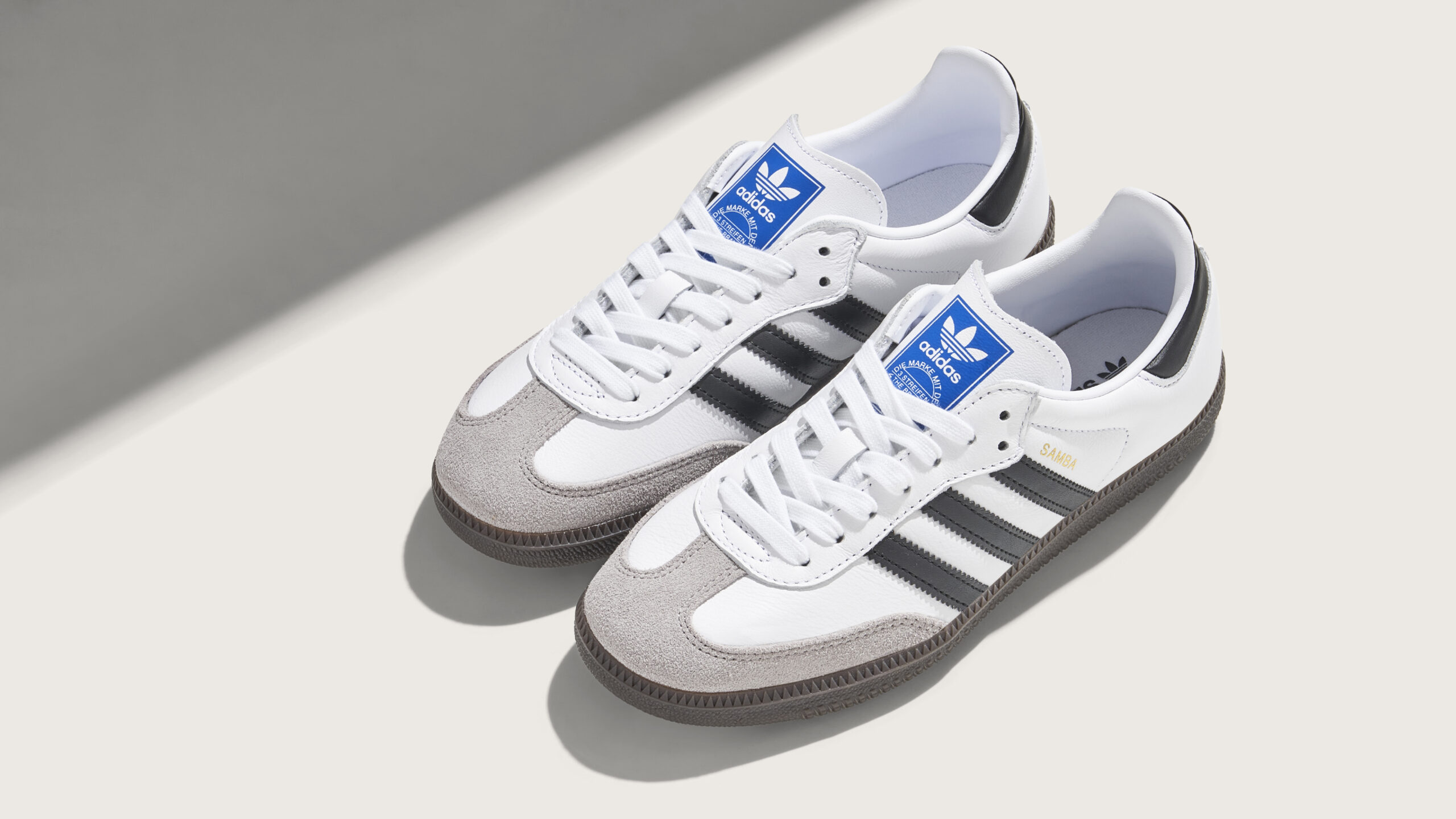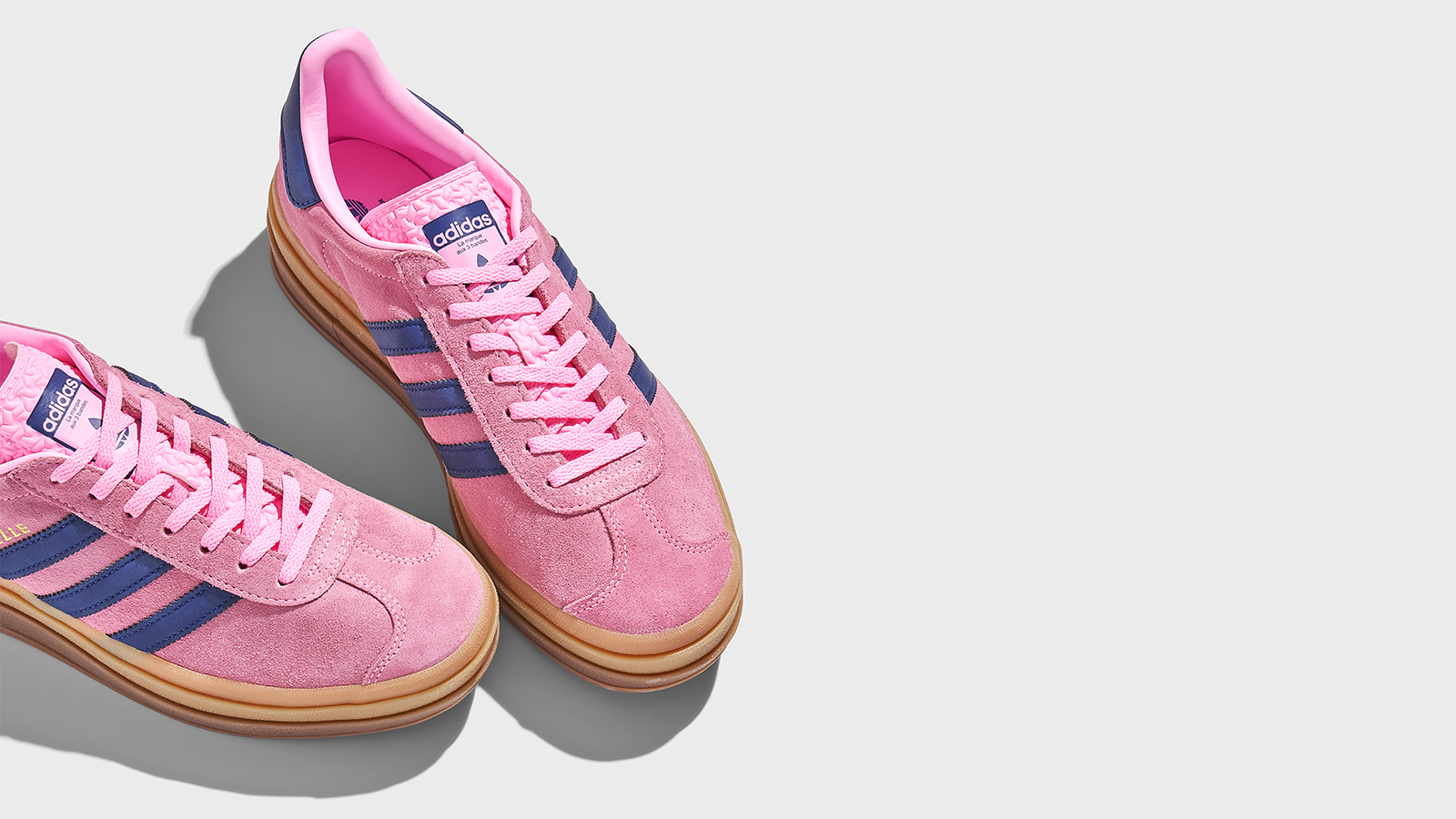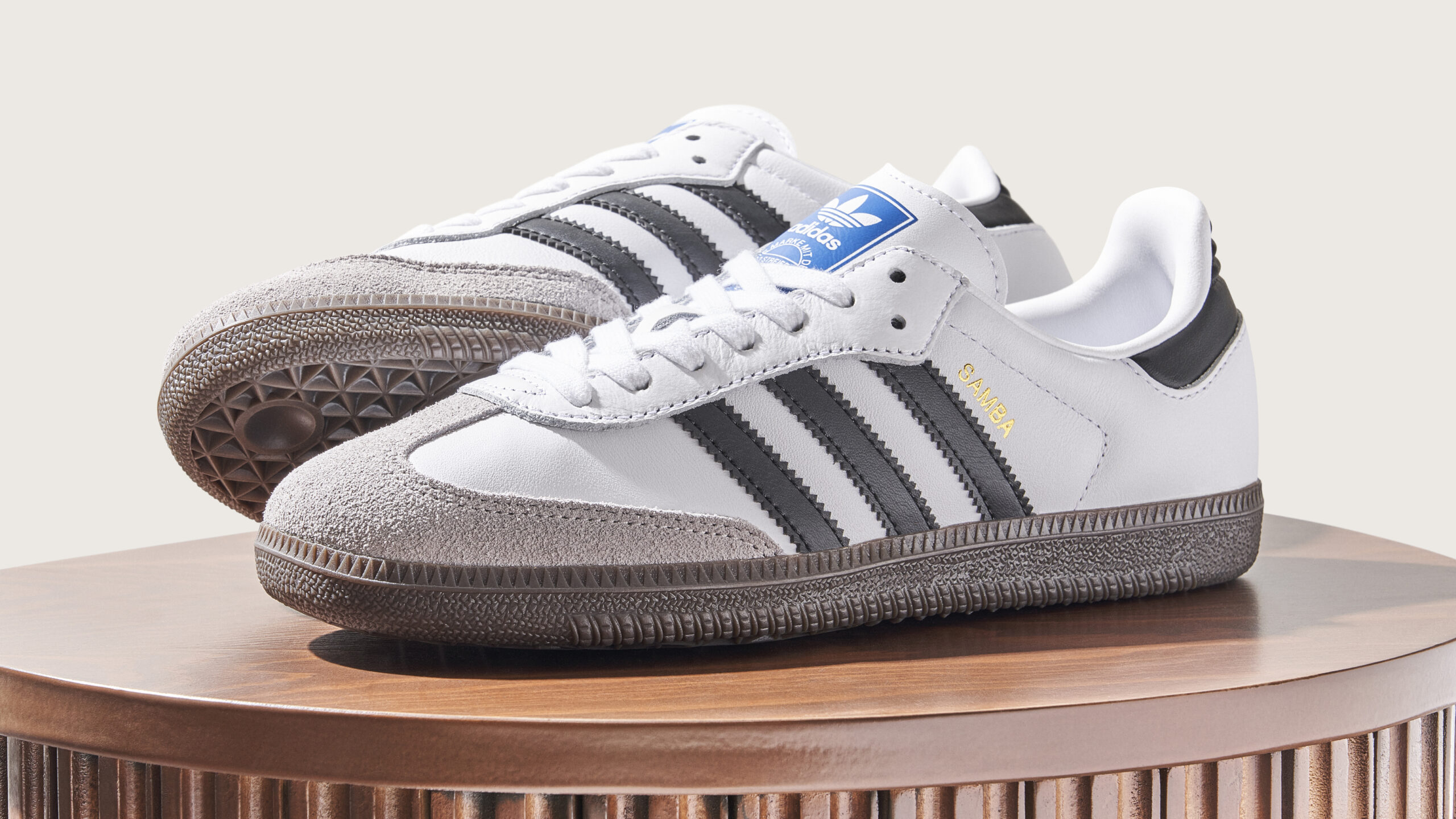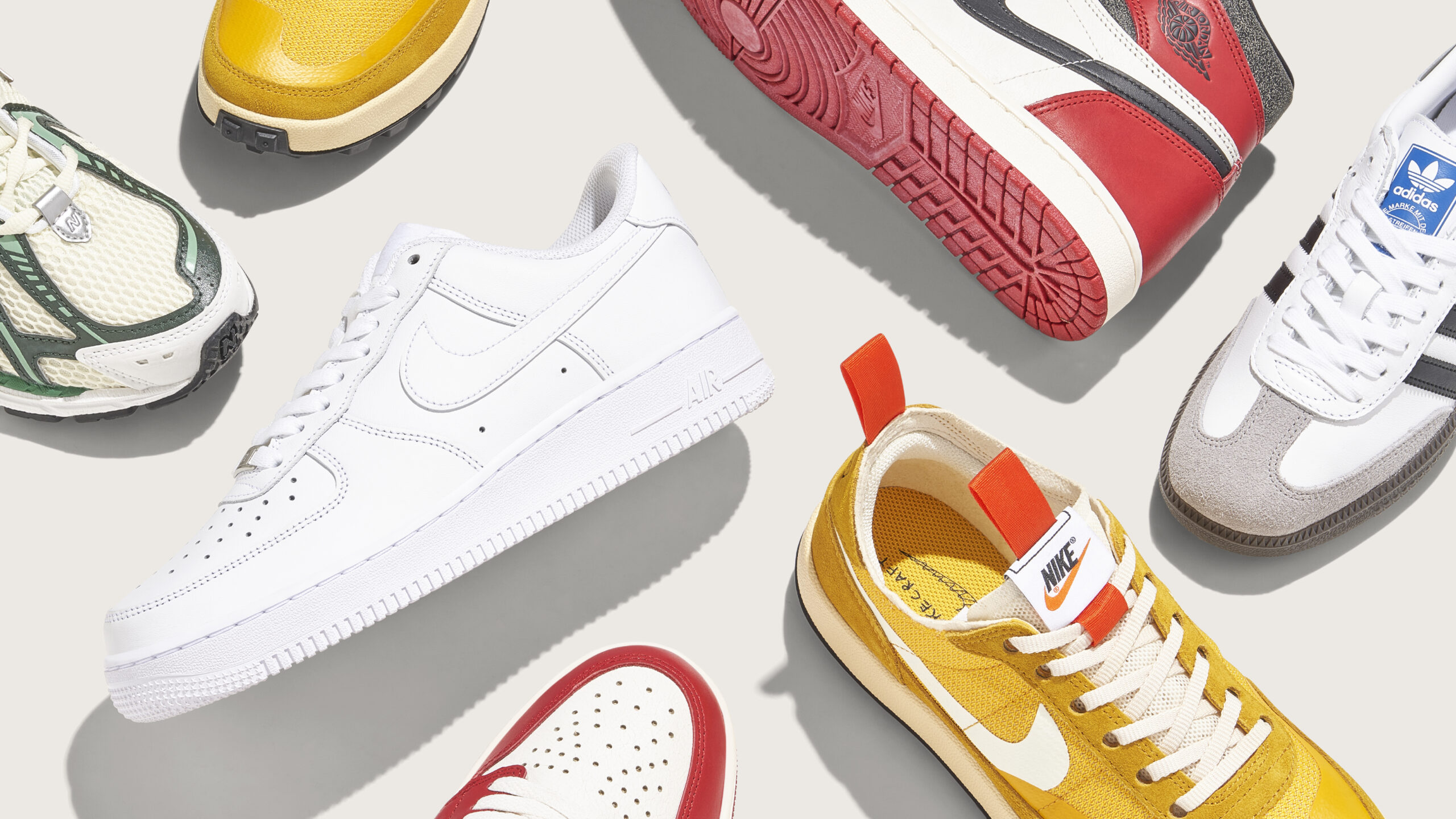The adidas Samba has undoubtedly become one of the most sought-after sneaker styles in the past few years. With searches for the shoe regularly hitting 80% up on last year, we thought it best to offer up our comprehensive overview and size guide, so that you can confidently make your purchase and jump on the Samba bandwagon.
The best sneakers have the ability to move beyond the initial purpose of their design, becoming timeless fashion icons. Look to adidas’ competitors like Nike, with the Air Jordan 1 or New Balance with the ever evolving 990 line. The Samba is a shoe that really embodies adidas’ brand. Originally released as solely a football shoe, the style has managed to change over the decades, moving from the pitch to the streets, and making a significant impact in both worlds. Like its cousins the adidas Superstar and the Stan Smith, the Samba has been able to reach a level of everyday awareness that sets it above its humble sportswear beginnings.
A Brief History of the adidas Samba
To properly appreciate the ongoing popularity of the Samba, we’ve got to look back to its origins, which date to the early 1950s. Adidas, a brand synonymous with innovative sportswear, spotted the need for a football boot that could provide better traction on icy and hard surfaces. Early design elements were rooted in functionality, and the Samba quickly gained favour among players due to its novel, innovative design. The name referred to the debut competition in which the Samba was put through its paces, the Brazil world cup held in 1950.
The Samba featured a leather upper, contrasting white sole and (now iconic) three stripes, along with a distinctive overlay on the toe that would eventually develop into the T-shaped suede panel we see on more contemporary iterations. These elements combined to create a shoe that excelled in grip and durability, making it a firm favourite on the football field. What changed over the years was the shift from a mid-height football boot, with screw-in studs (which made the shoe adaptable to pitch conditions), into a low top rubber soled shoe more suited for indoor sports, and everyday, casual wearing.
The adidas Samba managed to find its place in various subcultures by the 1980s. Having transitioned from being solely a sports shoe to a cultural icon embraced by skaters and musicians, while still maintaining a close tie with football and the cultural uniform that emerged from terrace style. Versatility and timeless design made it a classic that ignored generational shifts and trend cycles, securing its position as a true fashion icon.
Design and Features
A signature detail of the adidas Samba is the suede T-shape that sits on the toe box. The contrasting suede not only helps to make the shoe feel more premium, but also adds a retro design element to an otherwise minimal sneaker — it’s a feature that has been present in the shoes design DNA since its first appearance, and what started as a functional, performance focused detail has developed into an iconic silhouette.
Another distinctive feature that the Samba boasts is the gum rubber sole. However, it’s not unique. Although developed for the Bündeswehr in the ‘70s or ‘80s (and still unclear which Dassler brother initially designed the style), the German Army Trainer, or GAT also features a pale rubber gum sole and contrasting panel on the toe, perhaps hinting as to where Adi Dassler got the inspiration/opportunity to explore what the Samba would become.
The GAT was a firm favourite of legendary designer Martin Margiela who would buy up deadstock and vintage pairs of the sneakers after the fall of the Berlin wall, and give them a new lease of life by customising them. Once his resources of GATs ran dry, he moved on to remaking the silhouette out of luxury materials and named them the Replica.
As far as versatile design goes, the Samba is really the poster child right now. The timeless and minimal design of the OG White Black pairs allow the shoes to be easily dressed up to be worn with tailored, classic styled looks (as seen when the ‘quiet luxury’ trend took over this summer), along with much more casual styles that hark back to the sneakers origins — Sambas look as at home in a streetwear inspired outfit, with hoodies and t-shirts, as they do in more smart casual outfits with an overshirt and hard wearing denim.
Much like in the ‘80s, it seems that every niche aesthetic is able to adopt the Samba into their looks, helped of course by the wide range of collaborations that the sneaker has been the subject of over the past year.
Hugely acclaimed British label Wales Bonner has been consistently selling out pairs of their collaborative Sambas since 2020, LA based brand Sporty & Rich created a subtle variation for their SS23 collection and more recently Ronnie Feig of Kith joined up with adidas and Clarks for a three-way collaboration that saw the Samba take on the crepe sole of a Clarks Wallabee. Even the now head of luxury titan Louis Vuitton, and icon in his own right, Pharrell has released collaborative pairs under his Humanrace label.
Whatever your personal style, the widespread appeal of the Samba, and huge array of colourways available mean you’ll easily be able to find a pair that works for you.
Sporting Performance
It comes as no surprise that the Samba is still looked to when it comes to football, more specifically indoor football. Similar styles from adidas Originals like the Gazelle and the Spezial (both initially designed as an indoor Handball sneaker), are often confused for a Samba because they boast similar designs. This is, in part, down to the reputation and record that the design of the Samba has gained. The ‘if it’s not broke don’t fix it’ kind of approach.
In the years since the Sambas release however, the shoe has been adopted not just by subcultures, but by other sports too. Skateboarders took on the Samba due to its low profile and strong grip that make for a perfect skating sneaker, along with the durable upper and panelling being able to stand up against the inevitable scuffing and damage.
More recently, adidas released the Velosamba, a version of the sneaker that is designed solely as a cycling shoe. With built-in bungee laces that won’t get caught in pedals or chains, a reinforced midsole for stability and a built in two-bold compatible cleat. The Velosamba also showcases adidas’ evolving eco-friendly approach to their manufacturing, being made from fully natural and renewable materials.
Adidas Samba Sizing Guide
Sambas fit more on the narrow side than typical sneakers, so we recommend going up half a size if you’ve got a wider foot, but most people should find true to size the way to go. As Sambas are a unisex style, it’s worth keeping in mind that the UK sizing will run one size down for women’s (i.e a size 9 will be a women’s size 8 etc), so be sure to carefully look over the size chart to find your regular size before ordering.
It’s worth considering where you’re intending to wear your Sambas — if you’re primarily looking for a sports shoe, it might be worth sizing down a half size for a more snug fit and reduce any slipping. Conversely, if you’re wanting them for everyday use, size up a half size so you can wear them year round (thick sock season etc) and be more comfortable.



